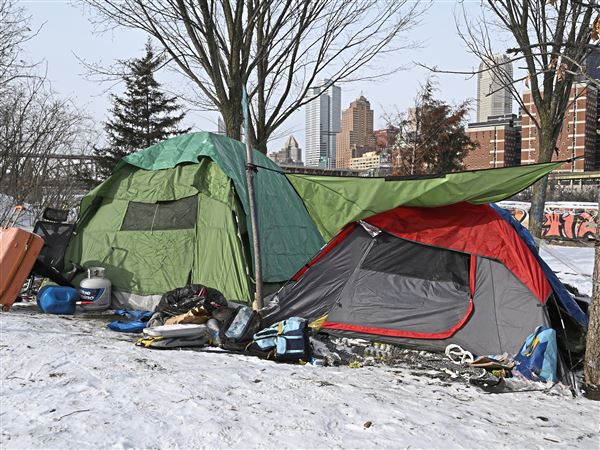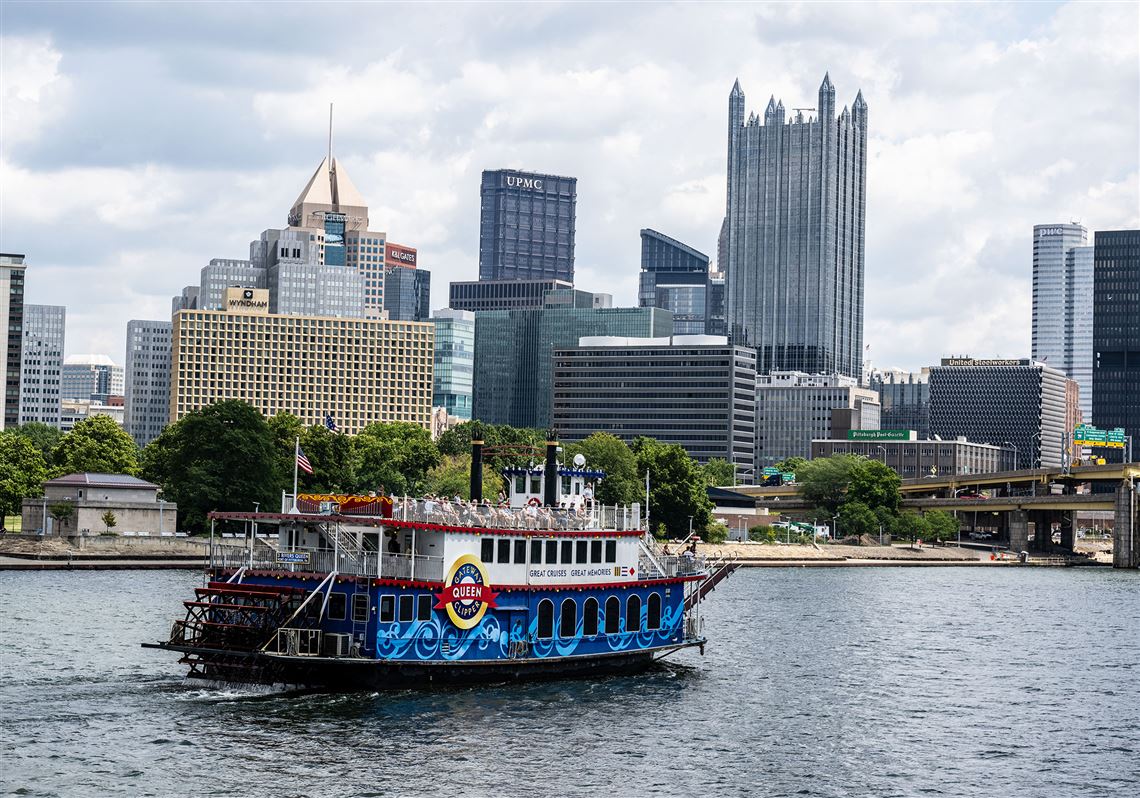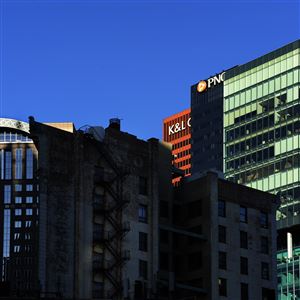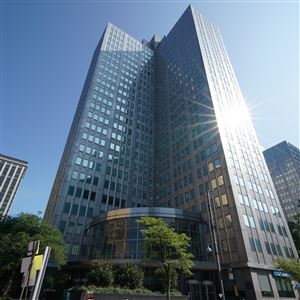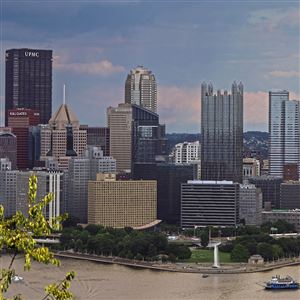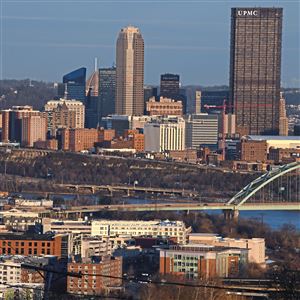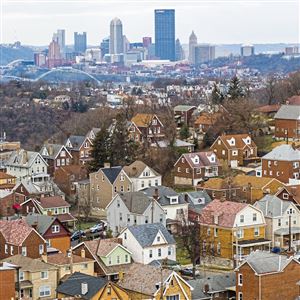Downtown Pittsburgh has been pummeled with record high office vacancy rates and expanses of space being offered up for subleasing. But the Steel City isn’t the only one struggling to right itself in the aftermath of the COVID-19 pandemic.
Other downtowns, including some larger than Pittsburgh as well as others of comparable size, are plagued with many of the same issues, according to statistics compiled by the Jones Lang LaSalle real estate firm.
The Golden Triangle, with a 19.8% direct office vacancy rate, is tied with San Francisco, which has become the poster child for what ails American cities coming out of the pandemic.
While high, that vacancy rate is within a percentage point or less of the central business districts in many other places, including many of Pittsburgh’s peer cities.
And in terms of sublease availability, Pittsburgh, at 3.7%, ranked in the middle of the pack, based on the JLL data.
“Every city is still dealing with post-pandemic sluggishness related to employees returning to the office, which in turn translates into less demand for office space,” said Dan Adamski, JLL senior managing director. “You are seeing companies at a much higher pace than pre-COVID putting sublease space on the market.”
The most disturbing trend is the overall vacancies, said Gerard McLaughlin, executive managing director of the Newmark real estate firm in Pittsburgh.
“The bottom line is that it’s not good for any city to have that much space available,” he said.
Among the cities listed by JLL, downtown Los Angeles had the highest office vacancy rate at 22.8%, and Detroit the lowest at 10.5%.
In terms of sublease availability, San Francisco took the top spot with 8.9%, while Baltimore had less than 1% available.
While Downtown Pittsburgh rivals San Francisco in terms of office vacancy, Mr. Adamski said there are key differences between the Steel City and the much larger Bay Area metropolis — one that’s dealing with its own safety and homelessness issues, prompting some big name retailers to close and leaving lots of empty buildings in the wake.
Downtown San Francisco has 23.7 million square feet more of office space, making the magnitude of the vacancy problem much greater. And in terms of total vacancy, including subleased space, San Francisco tops out at 28.3% compared to Pittsburgh’s 22.4%, he said.
In San Francisco, the tech sector makes up a “significant portion” of the tenant base, and many in that industry have embraced remote work, Mr. Adamski noted.
“Consequently, the city has experienced a talent exodus, with employees relocating to more affordable areas with better quality of life,” he added.
And while Downtown Pittsburgh has struggled with issues such as crime, homelessness, lewd behavior, and open drug use, they pale in comparison to those in San Francisco, said Mr. Adamski, who recently visited the California city.
“I hear about some of the issues San Francisco has — people complaining about entire blocks that are off limits. But in Downtown Pittsburgh, we don’t have that. We don’t have no-walk zones. When I stayed out there recently, the person working at the hotel told me don’t go past this street whatever you do because it’s not a safe area,” he said.
Downtown Pittsburgh has been dealing with shrinking office footprints and firms fleeing to the suburbs or other parts of the city — Strip District, anyone? — as employers adapt to hybrid work models.
In fact, in a report last month, JLL called for a reimagining of Downtown, one that trades older office buildings for more residential amid concerns about potential loan defaults caused by high vacancy rates and fewer people working in the city’s center.
Three is the magic number
While Downtown has been wrestling with rising office vacancy rates throughout the pandemic, Mr. Adamski sees hope for a turnaround.
Some Downtown employers, he said, are now pressing their workers to be in the office three to four or even five days a week. That, in turn, may factor into their decisions on reducing their space needs.
“What we’re finding is if an employee has to be in the office a minimum of three days a week, they want their own work station,” he said. “Even if they’re coming in three days a week instead of five, it greatly reduces the ability to downsize the company’s footprint because those people still want desks.”
That’s a whole lot different than an employee coming in one or two days a week, which makes it easier to mandate shared work spaces, he said.
“That’s really the tipping point,” he said, noting the three-day-a-week minimum creates a different mindset. “They want to be able to put pictures of their kids up. They want to know they’re going to be sitting in the same place every day and they can leave some items on their desk and have storage.”
Among the major Downtown employers pressing workers to be in the office more frequently are PNC Financial Services Group and insurer and health care provider Highmark. PNC has gone as far as offering employees discounted parking on the North Shore to entice them back.
But PNC spokeswoman Olivia Lammel said there is “not one enterprise-wide rule pertaining to return to the office.”
“It’s fair to say most PNC employees have been asked to work on-location at least a couple days a week, but the company has left it up to department leadership to determine what makes sense for their teams,” she said.
In April, Highmark Health urged leaders at the vice president level or above to be on site — whether a corporate office, hospital, or external stakeholder location — three days a week.
It has since “expanded that expectation to all team members who are not designated as off site,” spokeswoman Rachel Borowski said.
“This is not a mandate, and flexibility is key. We empower team members to choose days that maximize collaboration and fit best with their schedules,” she said.
That hasn’t stopped Highmark from looking to lease out five floors of space totaling 145,000 square feet at its Fifth Avenue Place headquarters Downtown. A spokesman has said the health care giant was reorganizing floors with an eye toward leasing out space even before the pandemic.
At Federated Hermes, the company adopted a hybrid model more than a year ago with workers generally in the office at least three days a week, with the option of working remotely on the others, spokesman Edward Costello said.
Mr. Adamski is expecting such back-to-the-office trends to continue.
“Specific to Downtown, I think there is some optimism that post-Labor Day, everybody’s expectation is to see more people Downtown,” he said. “We’re not going to hit where we were on March 18, 2020, but if we can get 70% of the way there, it’s going to make a lot of people happy.”
Reimagining Downtown
Not so sure is Curt Starr, managing director of Fischer and Co., which represents tenants.
While some of the firms represented by Fischer want to bring their workforce back for up to three days a week, “they’ve had quite a time making that the policy of the company and enacting that,” he said
Mr. Starr also sees some companies continuing to push for shared workspaces in order to save on square footage.
“Long term I think the jury is still out on that,” he said. “From a natural perspective, workers will want their own space.”
The bigger issue, he said, is whether tenants will stay Downtown when their leases end or bolt to the suburbs where there’s free parking and more amenities.
One Fischer client, he noted, recently moved into a building in a fringe market where there were more amenities. It also cut its office footprint in half.
“Some of these [building owners] are pumping more tenant amenities. I think they’re right to do that. I think tenants are truly evaluating that,” he said.
Mr. Adamski is well aware of such realities. Last month’s JLL report suggested that Downtown should strive to become more like the Strip, with livelier retail and a mix of office and residential options.
Downtowns need to be “a place where people want to be, thriving and vibrant,” he said.
“If you compare our Strip District to our (Downtown), it’s like a tale of two cities really. We’re not having to encourage anyone to go to the Strip District, right? They’re going there on their own and willingly and eager to do so. Whereas we’re all trying to figure out how to quote unquote make people come back Downtown,” he said.
Mr. Adamski expects Downtown Pittsburgh’s sublease availability rate to drop as building leases end and companies return the space to their landlords. But that doesn’t mean it’s a good thing.
As firms give back the space, it simply will increase the vacancy rate, he pointed out. That’s unless something changes.
As of July, about 63% of Downtown’s pre-pandemic workforce had returned to the office, according to the Pittsburgh Downtown Partnership. Just where it will settle is the big question, Mr. Adamski said, adding he doesn’t expect it to return to pre-COVID levels.
“The trend line has been inexorably higher, more people coming Downtown, more people returning to work. It’s been slower, I think, than almost anybody would prefer but it’s undeniable,” he said.
While worried about downtowns as a whole, Mr. McLaughlin likes Pittsburgh’s chances.
“I see [Downtown Pittsburgh] as no worse or no better than anyone else. We all have our problems and we need to overcome them. Pittsburgh has been very resilient over the years and I think we will continue to be resilient,” he said.
Mark Belko: mbelko@post-gazette.com
First Published: August 27, 2023, 9:30 a.m.
Updated: August 28, 2023, 5:28 p.m.



